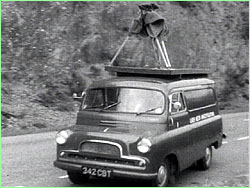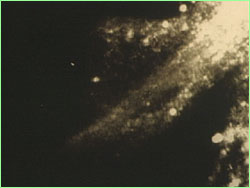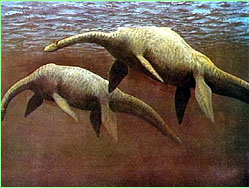
|

|

|
|
 In the 1960s a group of dedicated amateurs formed the
Loch Ness Investigation Bureau to keep a constant
vigil on the loch.
In the 1960s a group of dedicated amateurs formed the
Loch Ness Investigation Bureau to keep a constant
vigil on the loch.
|
Birth of a Legend
Part 2 |
back to part 1
In the 1950s, a local doctor named Constance Whyte began
collecting these eyewitness accounts, along with sketches of
what the people had seen, finally publishing them in 1957 as a
book entitled More Than a Legend. Noting that many of
her friends had been subjected to ridicule and contempt, Whyte
said her goal in writing the book was "the vindication of many
people of integrity who had reported honestly what they had
seen in Loch Ness." (To hear recent personal anecdotes, see
Eyewitness Accounts.)
Whyte's book inspired a new generation of monster hunters,
including Tim Dinsdale, who on his first visit to the loch in
1960 took an intriguing film of something moving across the
loch—and promptly gave up his career as an aeronautical
engineer to devote his life to pursuing the monster. The next
year, a group of dedicated amateurs formed the Loch Ness
Investigation Bureau, keeping a constant vigil on the loch
from an observation post on the northern shore.
 In 1987, Operation Deep Scan, the most ambitious
sonar survey of Loch Ness, found three unexplained
underwater targets.
In 1987, Operation Deep Scan, the most ambitious
sonar survey of Loch Ness, found three unexplained
underwater targets.
|
|
But perhaps the most important effect of Whyte's book was to
turn the tide of public opinion. Long dismissed as fodder for
"silly season" press reports, Nessie was finally considered a
subject worthy of serious scientific investigation. In the
span of a decade, beginning in 1958, four separate expeditions
were launched, first by the BBC, then by three respected
British universities: Oxford, Cambridge, and the University of
Birmingham. Rather than scanning the surface with binoculars
and cameras, as the amateur investigators had, these
expeditions came equipped with sonar, a military technology
that used sound to search the underwater environment. Though
the expeditions found nothing conclusive, in each case the
sonar operators detected large, moving underwater objects they
could not explain. (To learn how sonar works, see
Experiment with Sonar.)
|
 Taken in 1975, this photograph, which seems to show
the flipper of an aquatic creature, helped rekindle
interest in the monster.
Taken in 1975, this photograph, which seems to show
the flipper of an aquatic creature, helped rekindle
interest in the monster.
|
The use of technology to search the loch reached a new level
in the 1970s, when a series of expeditions was sponsored by
the Boston-based Academy of Applied Science, whose members
included many technically skilled people with ties to MIT. The
Academy's approach was to set a trap for the monster by
combining sonar and underwater photography for the first time.
Under the leadership of Robert Rines, a lawyer trained in
physics, the team pointed a sophisticated form of sonar,
called side scan sonar, out into Loch Ness from a point near
the shore. Nearby they placed an underwater camera taking
pictures every 45 seconds as a strobe light illuminated the
depths with a bright flash. The system paid off one night in
1975. At the same moment the sonar was registering a large,
moving object, the underwater camera was taking pictures of an
object that looked, after development and computer
enhancement, like the flippers of an aquatic creature.
Rines' discovery won the support of two reputable scientists:
Harold "Doc" Edgerton, the legendary MIT scientist who had
invented side scan sonar and strobe photography; and Sir Peter
Scott, one of Britain's most respected naturalists. With
Edgerton and Scott behind him, Rines was given an opportunity
to present his evidence at a hearing at the House of Commons
in London. Never had the possibility of the Loch Ness Monster
been taken so seriously.
 This painting by Sir Peter Scott, a respected British
naturalist, helped create the popular image of Nessie
as an ancient reptile called a plesiosaur.
This painting by Sir Peter Scott, a respected British
naturalist, helped create the popular image of Nessie
as an ancient reptile called a plesiosaur.
|
|
Almost immediately, however, critics began to raise questions
about the evidence. Could the suggestive sonar traces be the
result of human error? Had the flipper photos been altered to
improve their appearance? Just as damaging to Rines' case was
Peter Scott's bold pronouncement about the identity of the
creature. Based on the flipper photos and the eyewitness
sightings, Scott concluded that Nessie was a plesiosaur, an
ancient reptile that was thought to have gone extinct along
with the dinosaurs some 65 million years ago. The idea was
just too far-fetched for professional zoologists to take
seriously.
Although zoologists have yet to conduct the full-scale
investigation Rines hoped to trigger, the loch continues to
yield intriguing sonar hits. In 1987, an expedition called
Operation Deep Scan used a flotilla of 20 sonar-equipped boats
to sweep the loch with a curtain of sound; the operation
yielded three underwater targets that could not be explained.
In the early 1990s, the BBC's Nicholas Witchell helped
organize Project Urquhart, the first extensive study of the
loch's biology and geology. Although they weren't looking for
monsters, the expedition's sonar operators detected a large,
moving underwater target and followed it for several minutes
before losing it. And during the 1997 expedition featured in
NOVA's Loch Ness film, Rines and his longtime colleague
Charles Wyckoff detected yet another puzzling underwater
target. According to the expedition's sonar expert, marine
biologist Arne Carr, it was a moving target, appeared to be
biological in nature, and was about 15 feet long—the
size of a small whale.
Continue
Fantastic Creatures
|
Birth of a Legend
Eyewitness Accounts
|
Experimenting with Sonar
Resources |
Transcript
| Site Map |
Loch Ness Home
Editor's Picks
|
Previous Sites
|
Join Us/E-mail
|
TV/Web Schedule
About NOVA |
Teachers |
Site Map |
Shop |
Jobs |
Search |
To print
PBS Online |
NOVA Online |
WGBH
©
| Updated November 2000
|
|
|



 In the 1960s a group of dedicated amateurs formed the
Loch Ness Investigation Bureau to keep a constant
vigil on the loch.
In the 1960s a group of dedicated amateurs formed the
Loch Ness Investigation Bureau to keep a constant
vigil on the loch.
 In 1987, Operation Deep Scan, the most ambitious
sonar survey of Loch Ness, found three unexplained
underwater targets.
In 1987, Operation Deep Scan, the most ambitious
sonar survey of Loch Ness, found three unexplained
underwater targets.
 Taken in 1975, this photograph, which seems to show
the flipper of an aquatic creature, helped rekindle
interest in the monster.
Taken in 1975, this photograph, which seems to show
the flipper of an aquatic creature, helped rekindle
interest in the monster.
 This painting by Sir Peter Scott, a respected British
naturalist, helped create the popular image of Nessie
as an ancient reptile called a plesiosaur.
This painting by Sir Peter Scott, a respected British
naturalist, helped create the popular image of Nessie
as an ancient reptile called a plesiosaur.